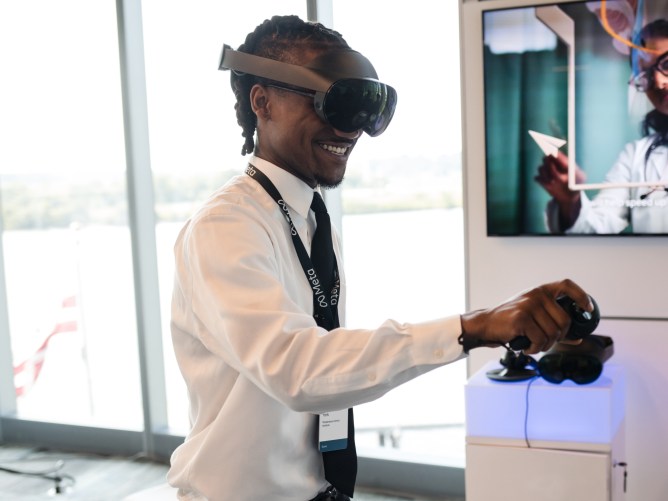
We believe the metaverse can transform learning and how people train for jobs, which is why we hosted the Future of Work Summit this week in Washington, D.C. Academics, policymakers, entrepreneurs and experts gathered to hear how immersive technologies like virtual and augmented reality (AR and VR) benefit businesses and workers.
“The metaverse promises to make learning more active,” said Nick Clegg, Meta’s President, Global Affairs. “With virtual and augmented reality technologies, people can learn by doing, not just passively absorbing information. This has the potential to transform the way we provide new skills and new lifelong learning tools for people in the future.”
Click to view slideshow.Here are five examples of how these technologies are shaping the future of work today:
Reducing Risk in Dangerous Work
Electricians often work on dangerous power lines and complex machinery, requiring experience and expertise. With VR training modules in platforms such as Interplay, an electrical apprentice can practice using virtual live wires hundreds of times without risking physical injury. And as they practice, trainers can provide guidance and assess their performance.
According to a recent whitepaper by ITIF, immersive technologies can be especially impactful in training programs that require a mix of theoretical and practical experience, and implementing AR- and VR-based instruction could make the programs more cost-effective, flexible and safe while extending their coverage.
Matthew Abeles from Associated Builders and Contractors (ABC), a US trade association, agreed. He said five chapters of ABC — Illinois, Ohio Valley, Southeastern Michigan, Iowa and New Jersey — implemented virtual reality in their apprenticeship programs and anticipates more widespread adoption because of its benefits.
Increasing Caregiver Empathy and Retention
Carrie Shaw, CEO of Embodied Labs, developed an immersive training platform to bridge a gap between caregivers and the people they serve. Her platform enables caregivers to simulate cognitive, auditory or vision loss with the help of virtual reality. Driven by her own experience as a caregiver for her mother with early onset Alzheimer’s, Shaw saw an opportunity to increase empathy and educate caregivers about regular challenges on the job to improve retention.
“Often people don’t know what they’re getting themselves into when taking on the role of a caregiver,” said Shaw. “This leads to frustration and can result in high turnover, which can be especially problematic as our population ages and more caregivers are in demand.”
To help healthcare professionals deliver positive patient experiences, Talespin offers soft skills training like effective communication and emotional intelligence. According to the VR learning platform, training in VR is four-and-a-half times more effective than e-learning or classroom learning, and can lead to a 275% increase in confidence on the job after training.
Adding Longevity to Careers
Workers in physically demanding trades like welding or sheet metal work often reach limits as they age. Working with their hands and getting to hard-to-reach job sites can become difficult. But the most expert workers are getting a new opportunity to continue their careers as trainers in VR.
“We’ve seen longtime workers extend their careers using VR platforms such as Interplay to learn new skills and change to less physical jobs within our industry,” said Michael Harris, administrator, International Training Institute, and a second-generation sheet metal worker. “They benefit from maintaining an income while learning new skills, and younger generations are more engaged in the training and motivated to improve by getting a higher score in training modules just like a game.”
Opening New Pathways for Jobs
According to a new report by Jobs for the Future, careers in extended reality (XR) are more accessible to people who don’t have college degrees or are searching for new jobs. In the same report, JFF found that 40% of the more than 40,000 job postings mentioning XR or similar technology required only a high school education or associate degree to be considered, or had no education requirements at all.
“These findings suggest that people who have been excluded or underrepresented in the technology sector because of education attainment barriers will soon be able to access, enter and advance through immersive technologies more easily,” said Alex Swartsel, managing director of Jobs for the Future. “For example, a learner can begin in an entry-level role such as XR technical support specialist and then up-skill to specialize for roles such as virtual-world design, sales, or consulting on immersive solutions for business needs.”
Immersive technology training presents promise to strengthen the competitiveness of small and medium-sized businesses. In the US alone, the metaverse could contribute between $402 billion and $760 billion by 2035, according to a report commissioned by Meta and produced by Deloitte.
“The metaverse is making its way into our economy and culture, and preparing for it now will help make a small business more competitive both in the short and long term,” said Karen Kerrigan, founder of the Metaverse Business Alliance.
Providing Alternatives to Physical Prototypes
As a multimedia artist, animator and former construction worker, Quittman Farmer helps developers create digital twins of residential and commercial real estate projects through his company, QUED Animations. Physical prototypes for large-scale projects can be costly to design and produce, which is limiting for small- and medium-sized businesses, especially in the early stages of development. But with designs in AR and VR, prototypes can be easily and quickly manipulated to new specifications, and multiple designers can collaborate to design a prototype in real-time from anywhere.
The post Five Ways the Metaverse Is Shaping The Future of Work appeared first on Meta.















 English (US) ·
English (US) ·